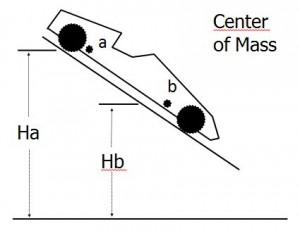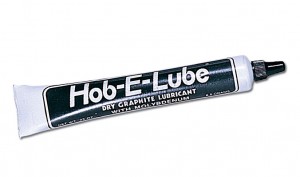This is a work in progress, I will be adding to it as time permits.
To win a Grand Prix race, your car must get from the starting line to the finish line before the other cars. OK that may sound kind of obvious but: Failure, Grinding stop, Dramatically flying off the track are all possible and can be avoided. If you can’t get to the finish line, you can’t win!
I have tried all of these, at least in an experimental capacity, and formed my opinions from those tests and whatever scientific evidence I could find.
Assure Ground Clearance, assure that the car will “run” on the track. The car must straddle the lane strip and not rub the strip with the underside of the car. The strip is usually 1/4″ high, that is why the clearance specs call for 3/8″. All the tracks I have used have a starting pin ¼” in diameter. A pointed nose may slide off the pin causing a slow start, or miss-start. Also the sensors under the finish line detects infrared light from above through a 1/4 inch hole to determine finish order, and times. A pointed nose CAN make a difference, and when 1/1000 of a second matters……
Cars should be as long as the rules allow, rear wheels as far back as rules allow and front wheels forward as far as rules allow, without affecting rear wheel location (longest allowed wheelbase) for best stability and speed. Longer wheelbases also means an easier alignment. In Awana you can put your wheels anywhere, as a general rule the wheels should not extend past the ends of the vehicle, but can be as long as you like without violating the overall dimensions rules.
To Be The Quickest: Accelerate early, Attain maximum velocity, Hold speed through finish line, Maximize weight vs. wind drag. As the aerodynamics of the cars shape improve, the weight of the car becomes somewhat less important. With good aerodynamics the car may lose a few places as its weight is reduced from 5 ounces. With poor aerodynamics, the loss of weight has more significant effect.
Optimize weight distribution. Car’s center of mass as far back as car stability allows, and car’s center of mass as low as possible. As the center of gravity moves farther back in the car, there is more energy available to be converted into speed. BUT If the center of gravity is too far back, the car loses stability and will “rattle around” toward the end of the race track. Locate the center of gravity about 3/4″ ahead of the rear axle. As long as the car is stable, weight distribution will affect the car’s performance only a few places. Having the weight “as far back” is more important to maximize potential energy. Weight as close to maximum allowed as possible, however I have had many lighter cars do very well.
Remember the wheels and axles are about .45 ozs so subtract that when making your car.
Car’s cross section as small as possible with wheels “in round”, and all sliding contact surfaces polished. Make sure that the wheels are in balance, in round, moving freely, and correctly aligned. If not, it will slow itself down as it rolls down the track! (hub and inside wheel edge) Hub contact area as close to wheel axis as possible to minimize breaking torque due to wheel-body and wheel-axle friction.
Fundamental Energy Equation: Potential Energy at start minus Lost Energy leaves Kinetic Energy at finish. In other words … Start with as much potential energy as you can, and waste as little of that energy as possible.

Here are some of the places to look for friction: Friction between wheel and axle, Friction between hub or wheel edge and car, Friction between hub and axle end, Air friction, Wheel vibration, Body oscillation (wheels out of round) (weight too far back), Wheel rolling friction, Wheel sliding friction on track or rail.
Regardless of the lane in which you race, you should race in: The steepest lane, The shortest lane, The smoothest lane, and The slickest lane Then, you will be racing in … The fastest lane! But if you don’t get to pick the lane, how do you make sure to get the fastest lane? By what you do to your car! Most Modern tracks have a drop followed by a flat run out. How do I make my lane steeper? Physics says that “my lane” is the path followed by my car’s Center of Mass. Move the Centre of Mass of your car. It isn’t about weight in the back pushing the car down the track… Or about weight in the front pulling the car down the track.
 It is about how far the car drops as it goes down the track. The amount of drop determines the amount of “potential energy” that can be turned into speed. With modern tracks, drop increases as Center of Mass is moved farther back in the car, without causing other problems. Set axles so that car runs straight and level. Align as required. Make sure the axles are smooth and free of burrs, including the inside edge of the head. This is much more important with BSA axles as they are using nails that have imperfections on the shaft and under the head, the Awana axles are hinge pins and are smooth when you get them. Smooth wheels but not polished. For Many years BSA wheels had a molding injection spot on the tread surface (this may have been corrected) and Awana Wheels have a molding nub on the inside edge of the wheel. Be careful not to change the shape of the tread, many organizations do not allow you to change the wheel shape or size. Inside edge of wheel smooth, most tracks use a raised rail to guide the cars down the track if you don’t sand off the injection molding nub it could jump the track or at least slow the car down. I had a car at one race that would jump up every now and then, it was weird because it didn’t do it all the time, I inspected the car and found one of the molding nubs was not completely removed, when the car drifted so that wheel made contact with the lane strip the car jumped as the nub caught the strip. I pulled out my trusty knife and the car was fixed and ran much better in the following heats. Of course the damage was done and although the child had a much improved race day the poor start could not be over come.
It is about how far the car drops as it goes down the track. The amount of drop determines the amount of “potential energy” that can be turned into speed. With modern tracks, drop increases as Center of Mass is moved farther back in the car, without causing other problems. Set axles so that car runs straight and level. Align as required. Make sure the axles are smooth and free of burrs, including the inside edge of the head. This is much more important with BSA axles as they are using nails that have imperfections on the shaft and under the head, the Awana axles are hinge pins and are smooth when you get them. Smooth wheels but not polished. For Many years BSA wheels had a molding injection spot on the tread surface (this may have been corrected) and Awana Wheels have a molding nub on the inside edge of the wheel. Be careful not to change the shape of the tread, many organizations do not allow you to change the wheel shape or size. Inside edge of wheel smooth, most tracks use a raised rail to guide the cars down the track if you don’t sand off the injection molding nub it could jump the track or at least slow the car down. I had a car at one race that would jump up every now and then, it was weird because it didn’t do it all the time, I inspected the car and found one of the molding nubs was not completely removed, when the car drifted so that wheel made contact with the lane strip the car jumped as the nub caught the strip. I pulled out my trusty knife and the car was fixed and ran much better in the following heats. Of course the damage was done and although the child had a much improved race day the poor start could not be over come.
Many Speed Tip Sites mention raising 1 wheel to reduce friction, what they don’t tell you is it rarely works if it isn’t done perfectly. First of all raising 1 wheel adds friction to the other 3, and can cause the car to jump the track if raised too far, don’t forget the lane strip is only a 1/4″ high. Also the opposite wheel needs to be turned slightly to ride against the lane strip so it doesn’t jump off, adding friction back to the car.
Some mention canting the wheels so the car rides on the edge of the tread but this adds friction to the axle and adds the possibility of the wheels rubbing on the side of the car body.
In my opinion it does not work unless done perfectly, it is very difficult to do correctly.
Use a good dry lubricant like Hob-E-Lube, graphite with Molybdenum by PineCar.
Oils attract dust and will gum up and slow down over time, and can harm the finish on your car and the track. Other products like dry white with teflon are cleaner but do not work as well in my trials. I have raced with other extra fine graphite and it works but not as well as this. Most groups only allow lubrication once at the beginning of racing and this lube will actually get faster after a short break-in period, so spinning the wheels a few times to check the spin time could also help the car run faster, but don’t over do it. If possible lube both sides of the wheel on the inside of the wheel next to the car body and between the wheel and hub (head of the axle). Spin gently to distribute the graphite, then a good spin to check the spin time.
In my experience the graphite will last about 8 to 10 runs without significant loss of speed. If your race is planned for many more runs than this you my want to consider a re-lube pit stop at the half way point.
Here is a video on YouTube that explains the science behind how much each item effects speed and why, although all these make a difference, some items are much more important and some may not be worth your time.

